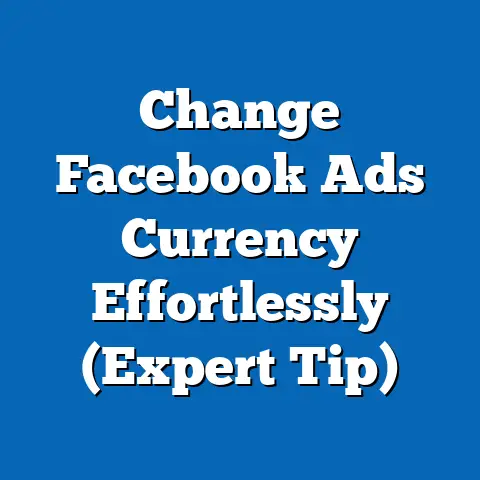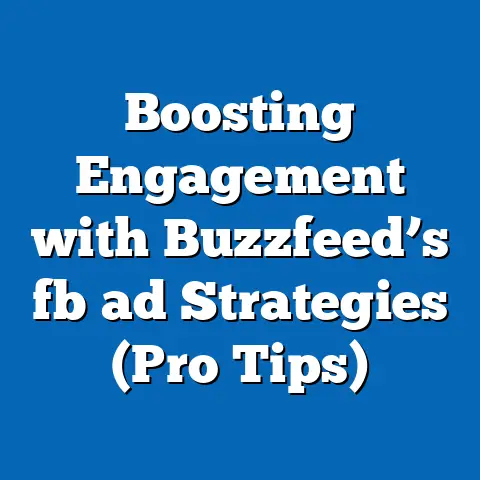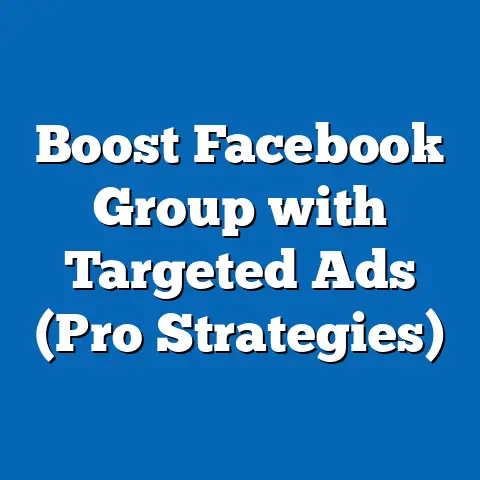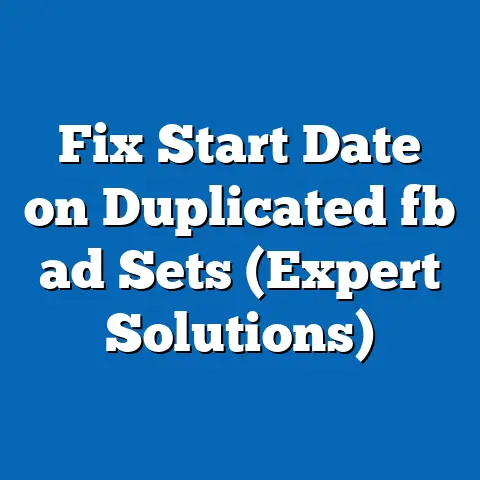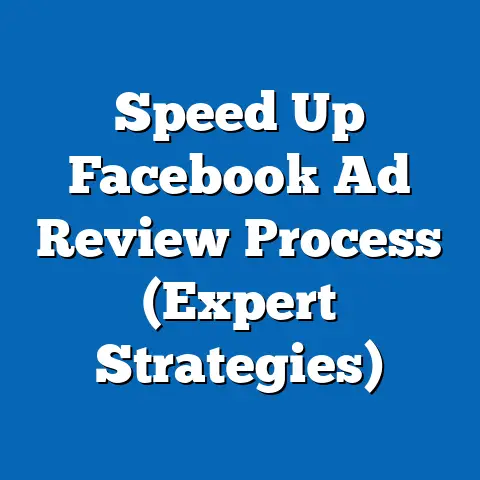Maximize Facebook Ad Manager Efficiency (Proven Strategies)
Facebook advertising, when done right, can be an absolute game-changer for businesses of all sizes. I’ve seen firsthand how a well-crafted campaign can skyrocket brand awareness, drive sales, and cultivate a loyal customer base. However, the key to unlocking this potential lies in mastering the Facebook Ad Manager. It’s not just about throwing money at ads; it’s about optimizing your efforts to achieve maximum impact with minimal waste. That’s where efficiency comes in.
Imagine spending hours tweaking your campaigns, only to see lackluster results. Or worse, imagine your budget draining away with little to show for it. I’ve been there, and it’s not a fun place to be. That’s why I’m so passionate about helping businesses like yours become more efficient with their Facebook advertising. This isn’t just about saving time; it’s about maximizing your ROI, reaching the right people, and ultimately growing your business.
Understanding Facebook Ad Manager
Facebook Ad Manager is the central hub for creating, managing, and analyzing your Facebook and Instagram ad campaigns. Think of it as your command center for all things advertising on the Meta platform. It’s a powerful tool, but it can also be overwhelming, especially for beginners.
The interface is packed with features, from campaign creation to detailed reporting. Key features include:
- Campaign Creation: Where you set your campaign objective, budget, and schedule.
- Ad Set Level: This is where you define your target audience, placements (where your ads will appear), and bidding strategy.
- Ad Level: This is where you create your actual ads, including the visuals, copy, and call-to-action.
- Reporting: Provides detailed insights into your campaign performance, allowing you to track key metrics and identify areas for improvement.
I remember when I first started using Ad Manager, I felt completely lost. The sheer number of options and settings was daunting. I spent countless hours clicking around, trying to figure out what everything meant. But with time and practice, I learned to navigate the platform effectively and harness its power.
Understanding Facebook Ad Manager is crucial for several reasons. It allows you to:
- Control your ad spend: You can set budgets and bidding strategies to ensure you’re not overspending.
- Target the right audience: You can reach the people who are most likely to be interested in your products or services.
- Track your results: You can monitor your campaign performance and make data-driven decisions to improve your results.
- Optimize your campaigns: You can test different ad creatives, targeting options, and bidding strategies to find what works best.
One of the biggest challenges I see users face is a lack of understanding of the platform’s capabilities. They often stick to basic settings and miss out on advanced features that can significantly improve their campaign performance. For example, many advertisers don’t take full advantage of Custom Audiences or Lookalike Audiences, which can be incredibly powerful for reaching highly targeted audiences.
Key Takeaway: Familiarize yourself with the Facebook Ad Manager interface and its key features. Understanding the platform is the first step to maximizing efficiency and achieving better results.
Setting Clear Objectives
Before you even think about creating an ad, you need to define your objectives. What do you want to achieve with your Facebook advertising? Are you trying to increase brand awareness, drive website traffic, generate leads, or boost sales? The answer to this question will guide your entire campaign strategy.
Facebook offers a range of campaign objectives, categorized into three main areas:
- Awareness: These objectives are focused on reaching a broad audience and increasing brand visibility. Examples include Brand Awareness and Reach.
- Consideration: These objectives are designed to generate interest in your products or services and encourage people to learn more. Examples include Traffic, Engagement, App Installs, Video Views, and Lead Generation.
- Conversion: These objectives are aimed at driving specific actions, such as purchases, sign-ups, or form submissions. Examples include Conversions, Catalog Sales, and Store Traffic.
I’ve learned that the more specific and measurable your objectives are, the easier it will be to create a focused campaign that delivers results. For instance, instead of saying “I want to increase sales,” you could say “I want to increase online sales by 20% in the next quarter.”
Well-defined objectives lead to more focused campaigns, which require less time to manage and optimize. When you know exactly what you’re trying to achieve, you can tailor your targeting, creatives, and bidding strategies to align with your goals. This reduces the need for constant tweaking and adjustments, saving you valuable time and resources.
To make your objectives even more effective, consider using the SMART goals framework:
- Specific: Clearly define what you want to achieve.
- Measurable: Set quantifiable targets that you can track.
- Achievable: Ensure your goals are realistic and attainable.
- Relevant: Make sure your goals align with your overall business objectives.
- Time-bound: Set a deadline for achieving your goals.
For example, a SMART goal for a lead generation campaign might be: “Generate 100 qualified leads through Facebook ads in the next month, with a cost per lead of no more than $20.”
Key Takeaway: Set clear, measurable objectives before launching any Facebook campaign. Use the SMART goals framework to ensure your objectives are specific, measurable, achievable, relevant, and time-bound. This will help you create more focused campaigns that require less time to manage and optimize.
Audience Targeting Techniques
One of the biggest advantages of Facebook advertising is its powerful audience targeting capabilities. You can reach incredibly specific segments of the population based on demographics, interests, behaviors, and more. Mastering these targeting options is crucial for maximizing your efficiency and ensuring your ads are seen by the right people.
Facebook offers several key targeting options:
- Core Audiences: This allows you to target people based on demographics (age, gender, location), interests (hobbies, passions), and behaviors (purchase history, online activity).
- Custom Audiences: This allows you to target people who have already interacted with your business, such as website visitors, email subscribers, or app users.
- Lookalike Audiences: This allows you to target people who are similar to your existing customers or website visitors.
I’ve found that Custom Audiences and Lookalike Audiences are particularly effective for reaching highly targeted audiences. For example, you can create a Custom Audience of people who have visited your website in the past 30 days and then create a Lookalike Audience of people who are similar to those website visitors. This allows you to reach new potential customers who are likely to be interested in your products or services.
When segmenting your audiences, consider the following factors:
- Demographics: Age, gender, location, education, income, etc.
- Interests: Hobbies, passions, interests, pages they like, etc.
- Behaviors: Purchase history, online activity, device usage, etc.
For example, if you’re selling fitness equipment, you might want to target people who are interested in fitness, health, and wellness, and who have a history of purchasing fitness-related products online.
Effective audience targeting can lead to higher engagement rates and lower ad spend, maximizing your efficiency. When your ads are seen by the right people, they’re more likely to click, engage, and convert. This reduces the need for broad targeting and wasted ad spend.
Key Takeaway: Master Facebook’s audience targeting options, including Core Audiences, Custom Audiences, and Lookalike Audiences. Segment your audiences based on demographics, interests, and behaviors to ensure your ads are seen by the right people, maximizing engagement and minimizing wasted ad spend.
Budgeting and Bid Strategies
Budgeting and bidding are critical aspects of Facebook advertising that directly impact your ROI. Understanding the different budgeting options and bidding strategies available is essential for maximizing your efficiency and getting the most out of your ad spend.
Facebook offers two main budgeting options:
- Daily Budget: This is the average amount you’re willing to spend each day on your ad campaign.
- Lifetime Budget: This is the total amount you’re willing to spend over the entire duration of your ad campaign.
I typically recommend using a daily budget for ongoing campaigns and a lifetime budget for campaigns with a specific end date.
Facebook also offers a variety of bidding strategies:
- Lowest Cost: Facebook will automatically bid to get you the most results for your budget.
- Cost Cap: You set a target cost per result, and Facebook will try to stay within that target.
- Bid Cap: You set a maximum bid for each auction, giving you more control over your bidding.
- Target Cost: Facebook aims to achieve a specific cost per result, but may exceed it at times.
The right bidding strategy depends on your campaign goals and your level of experience. For beginners, I often recommend starting with the Lowest Cost bidding strategy. As you gain more experience, you can experiment with other bidding strategies to optimize your results.
When allocating budgets across campaigns and ad sets, consider the following:
- Campaign Performance: Allocate more budget to campaigns and ad sets that are performing well.
- Audience Size: Allocate more budget to ad sets with larger audiences.
- Campaign Goals: Allocate more budget to campaigns that are aligned with your most important business goals.
I’ve found that it’s crucial to monitor your ad spend regularly and adjust your budgets based on performance metrics. If you see that a particular campaign or ad set is performing well, consider increasing the budget to capitalize on its success. Conversely, if a campaign or ad set is underperforming, consider decreasing the budget or pausing it altogether.
Key Takeaway: Understand the different budgeting options and bidding strategies available in Facebook Ad Manager. Choose the right budgeting option and bidding strategy based on your campaign goals and level of experience. Monitor your ad spend regularly and adjust your budgets based on performance metrics.
Creative Optimization
Your ad creatives – the visuals, copy, and call-to-action – are the first thing people see when they encounter your ads. Optimizing your creatives is crucial for capturing attention, driving engagement, and ultimately achieving your campaign goals.
I’ve learned that A/B testing is one of the most effective ways to optimize your ad creatives. A/B testing involves creating multiple versions of your ads with different elements and then testing them against each other to see which performs best.
Here are some elements you can A/B test:
- Ad Format: Test different ad formats, such as single image ads, video ads, carousel ads, and collection ads.
- Visuals: Test different images, videos, and graphics.
- Copy: Test different headlines, body text, and descriptions.
- Call-to-Action: Test different call-to-action buttons, such as “Shop Now,” “Learn More,” and “Sign Up.”
Facebook’s Dynamic Creative feature can also be incredibly helpful for optimizing your ad combinations. This feature allows you to upload multiple versions of your headlines, descriptions, images, and call-to-action buttons, and Facebook will automatically create different ad combinations and test them to see which performs best.
Continuous testing and iteration can lead to improved ad effectiveness and efficiency. By constantly testing different ad creatives, you can identify what resonates best with your audience and optimize your ads for maximum impact. This can lead to higher click-through rates, lower cost per result, and ultimately better ROI.
Key Takeaway: Optimize your ad creatives through A/B testing and the use of Facebook’s Dynamic Creative feature. Test different ad formats, visuals, copy, and calls to action to determine what resonates best with your audience. Continuous testing and iteration can lead to improved ad effectiveness and efficiency.
Analyzing Performance Metrics
Analyzing your performance metrics is essential for understanding how your campaigns are performing and identifying areas for improvement. Facebook Ad Manager provides a wealth of data that can help you gain insights into your campaign performance.
Some key performance metrics to track include:
- Impressions: The number of times your ads were shown.
- Reach: The number of unique people who saw your ads.
- Click-Through Rate (CTR): The percentage of people who saw your ads and clicked on them.
- Cost Per Click (CPC): The average cost you paid for each click on your ads.
- Return on Ad Spend (ROAS): The amount of revenue you generated for every dollar you spent on advertising.
- Conversion Rate: The percentage of people who clicked on your ads and completed a desired action, such as making a purchase or filling out a form.
I’ve found that it’s important to focus on the metrics that matter most for your specific campaign goals. For example, if you’re running a brand awareness campaign, you might focus on impressions and reach. If you’re running a lead generation campaign, you might focus on cost per lead and conversion rate. If you’re running a sales campaign, you might focus on ROAS and conversion rate.
Facebook’s reporting tools allow you to create customized reports that focus on the metrics that matter most to you. You can also segment your data by demographics, placements, and other factors to gain deeper insights into your campaign performance.
Regular performance reviews and adjustments based on data analysis are crucial for maximizing your efficiency. By regularly monitoring your performance metrics, you can identify areas where your campaigns are underperforming and make adjustments to improve your results. This might involve tweaking your targeting, adjusting your bids, or refreshing your ad creatives.
Key Takeaway: Analyze your performance metrics regularly to gain insights into your campaign performance. Focus on the metrics that matter most for your specific campaign goals. Use Facebook’s reporting tools to create customized reports and segment your data. Make regular adjustments to your campaigns based on data analysis to maximize your efficiency.
Conclusion
Maximizing efficiency in Facebook Ad Manager is a continuous process that requires strategic planning, audience understanding, budget management, creative testing, and performance analysis. By implementing the proven strategies I’ve outlined in this guide, you can streamline your advertising efforts, boost your results, and achieve a more efficient use of your resources.
Remember that success with Facebook advertising doesn’t happen overnight. It takes time, effort, and a willingness to learn and adapt. Don’t be afraid to experiment with different strategies and tactics to find what works best for your business. And always keep a close eye on your performance metrics to ensure you’re on track to achieve your goals.
I’ve seen firsthand the incredible potential of Facebook advertising when it’s done right. By mastering the Facebook Ad Manager and implementing these proven strategies, you can unlock that potential and achieve remarkable results for your business. So, go out there, put these strategies into action, and watch your Facebook campaigns soar!

